Rich bone broth is nutritious, flavor-packed, and easy to make. This classic slow cooker recipe produces a savory bone broth that you can enjoy as a nourishing drink during cold winter days.
But there are so many other ways to use bone broth. Enjoy it for breakfast, make bone broth hot chocolate, or add richness to soups, stews, sauces, and other quick weeknight meals—I'm sharing my favorite ways and recipes.
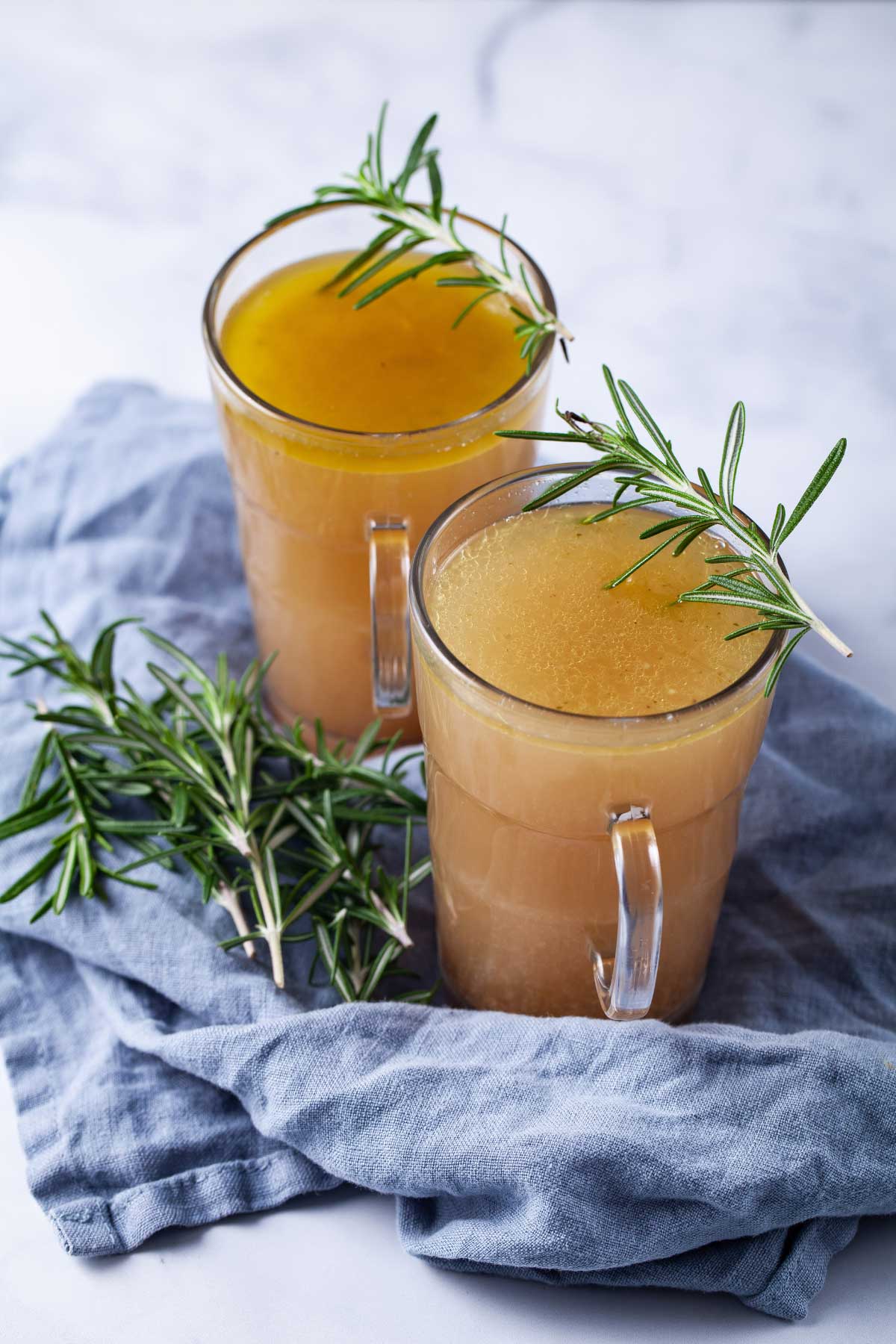
Making bone broth is nothing new. Homemade long-simmered (bone) broths or stocks have been around for a long time. But it's so much easier when using a slow cooker. You just set it and forget it; this recipe doesn't have a long cooking time either. I'm going for 8 hours, just enough to produce hearty flavors with the help of aromatic vegetables and enough bones! It's healthy, delicious, easy to make, and great for a low-carb or Paleo lifestyle.
Here's everything you need to know about how to make bone broth in a slow cooker.
Also, check out my How To Poach a Chicken recipe and 35 Easy Homemade Recipes For Chicken Broth.
Why You'll Love This Crock-Pot Bone Broth Recipe
- Nourishing: Bone broth contains nutrients like collagen, amino acids, and minerals (calcium, magnesium, potassium) that support gut health. Slow-cooking the bones releases these nutrients, making bone broth a rich, health-boosting drink or soup base. Like chicken soup, it's easy to consume and feels like a good old hug in a bowl.
- Super Easy & Affordable: With leftover bones, affordable vegetables, and a few additions, you can make the best bone broth at home. It's so much easier and cheaper than store-bought. It's also a perfect recipe to use up vegetable scraps.
- Great for Meal Planning: Bone broth is versatile and can be used in various recipes, from soups and stews to sauces and risotto. You can make a large batch, store it in the fridge or freezer, and use it throughout the week, making it great for meal prepping, planning, or adding extra flavor to your meals.
Ingredients & Notes
See the recipe card for full information on ingredients and quantities.
Here's what you need to make this slow cooker bone broth recipe:
- Animal Bones: Buy bones with some or still enough meat on them. It is key to a great bone broth that's deliciously nutritious and tasty. You can use beef bones, lamb bones, pork bones, etc. I usually get them from my farmer's market or local butcher. Check out my How To Poach a Chicken recipe to make a broth using a whole chicken.
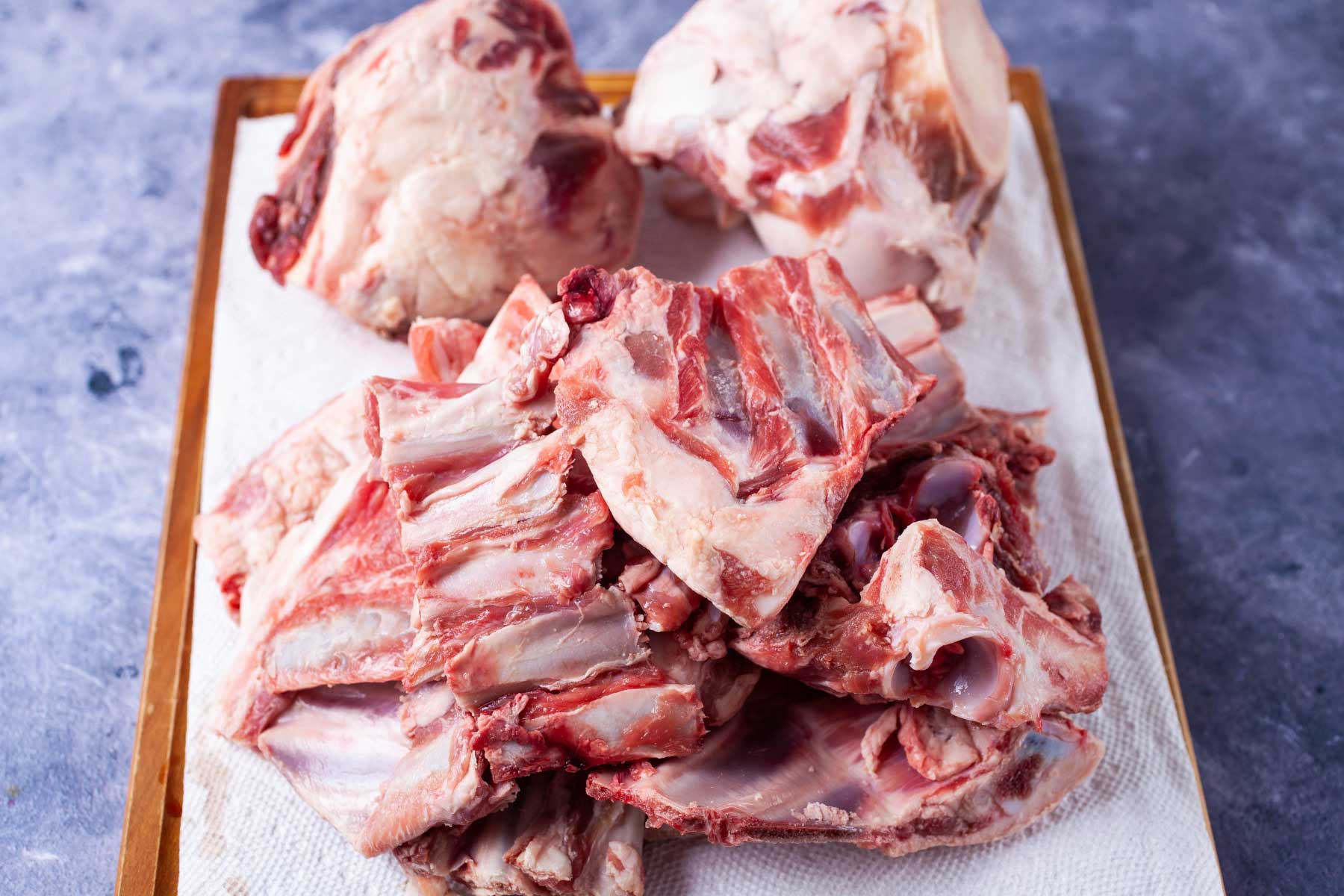
- Vegetables or Vegetable Scraps: I often make my bone broth with vegetable scraps from leftovers in the fridge. Ultimately, you will strain the broth and discard the vegetable solids anyway. You can use the ends, peels, roots, stalks, and leaves from vegetables such as carrots, shallots, and onions. Other great options to add flavor are celery and leeks. Yellow onions, scallions, and celery are my favorites to add to a broth, so sometimes I throw in the whole vegetable. The sweetness of a yellow onion and the buttery heartiness of celery add a beautiful richness and extra flavor!
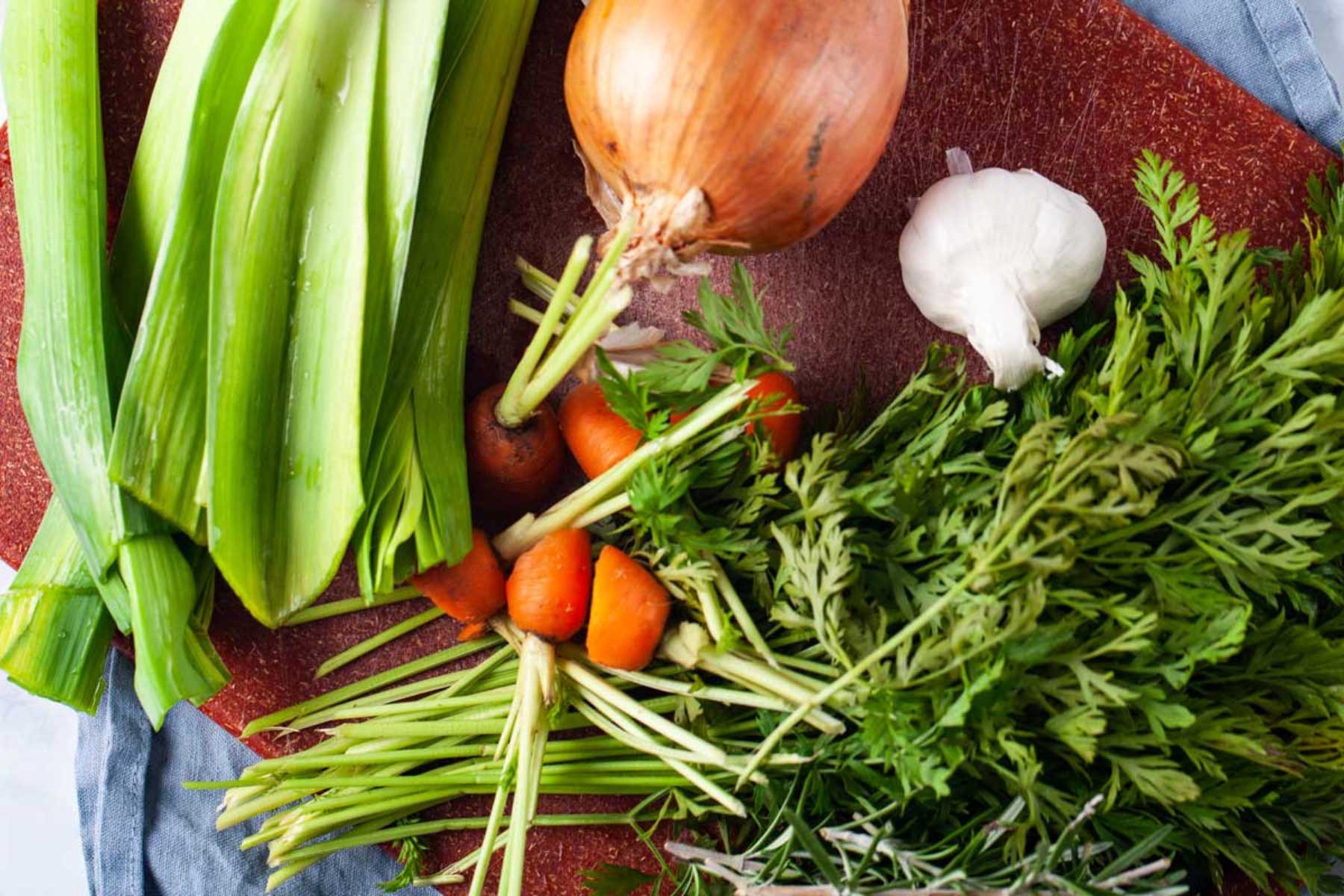
- Herbs: Feel free to discover which herbs you like best. You can't go wrong with adding dried or fresh herbs like Thyme and Rosemary sprigs. I highly recommend garlic. Although it is botanically a vegetable, I use it as an herb here. Garlic softens during the long simmer, and its intense flavors become sweeter and mellow. Its distinct taste perfectly balances out all the other characteristics of this broth.
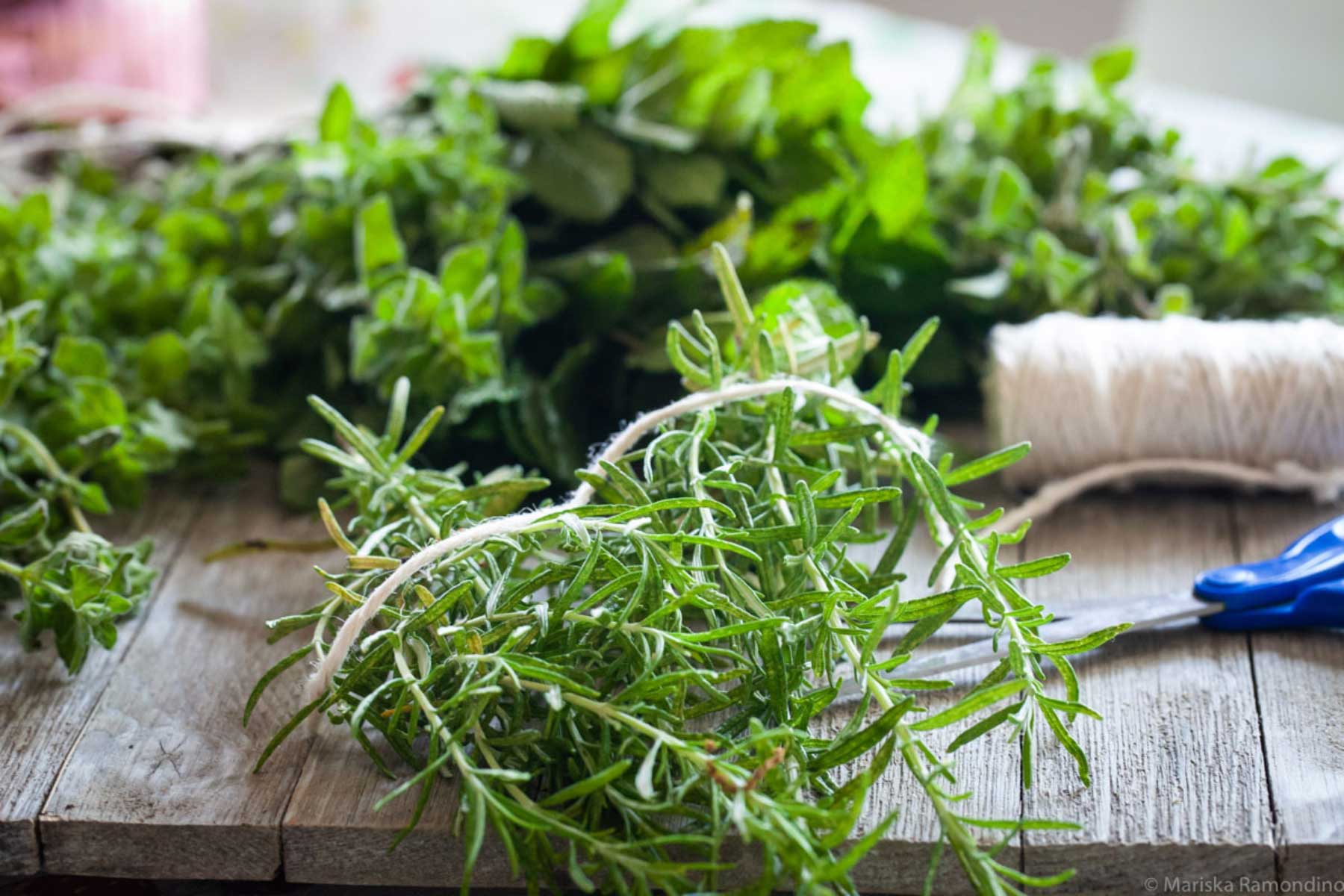
- Sea Salt or Himalayan Salt: I don’t put a lot of salt in my broth; it's just enough to give it some taste and as an extra nutrient. Depending on preference, you can add some salt later when serving the broth individually as a drink or using it as a base for other dishes.
- Other Seasoning (optional): Vegetable Broth Seasoning or Vegetable and Gluten-Free Bouillon Cubes instantly add a deep flavor and make the bone broth a worthy drink.
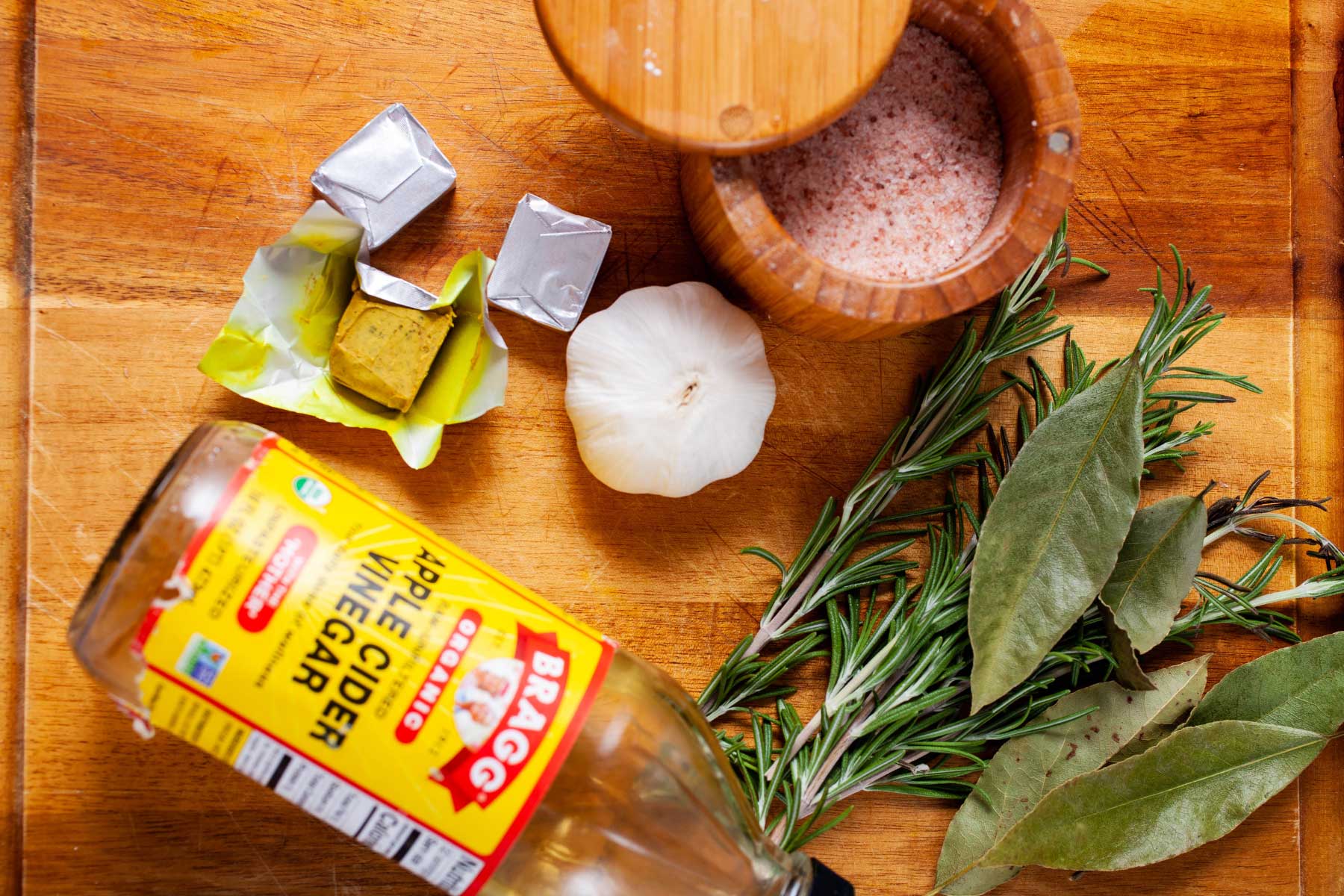
- Apple Cider Vinegar or Tomato Paste (optional): Due to its acidity, mild-flavored apple cider vinegar is said to extract minerals from the bones. I like it because a touch of this fermented liquid helps balance out the overall flavors and fattiness of the broth. Instead of apple cider vinegar, you could also use tomato paste to add a different but balanced sweet taste.
- Additional Add-Ons to Increase the Flavor (options):
- Green onions
- Leeks
- Carrots
- Pepper
- Whole peppercorns
- Red pepper flakes
- Parsley
- Bay leaves
- Sage
- Ginger
- Turmeric
- Onion powder
What Kind Of Bones
You want this bone broth recipe to be so tasty that you can sip on it for breakfast (and you want to because it's savory, hearty, and satisfying). But you won't get those rich flavors with bare bones alone (without meat).
So go for bones with a small amount of meat clinging to them. I also love to throw in some marrow bones.
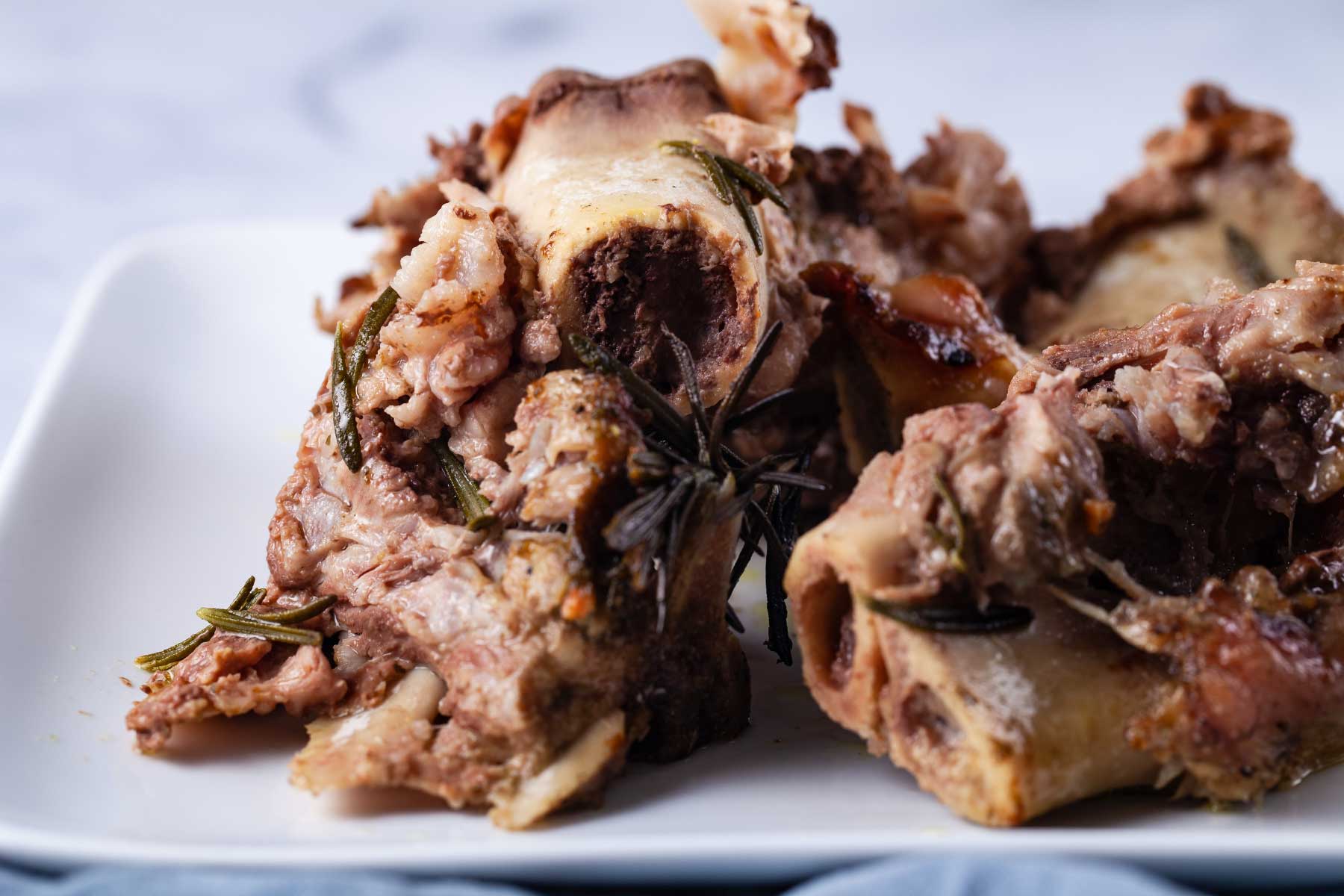
My favorites are:
- I like soup bones that still have some meat on them. I usually go for beef, pork, or oxtail bones.
- You can also go for marrow and knucklebones. I prefer to mix them with other meatier bones to give the broth lots of collagen and a richer body.
- Meaty short ribs or neck bones (chicken neck bones here are my favorite).
- You can also use big beef bones from a roast you made (leftovers).
- If you're using bones that lack meat, throw in some meaty cuts to give it that hearty slurping flavor.
Should I Roast My Bones First
Short answer: I don't, but there is no right or wrong here. It depends on what type of bones you will use to make your bone broth. Let's have a look.
Plan To Use Bare Bones Only:
- If you plan to use bare bones without much meat, I can see why you would want to roast the bones first. You will not extract much flavor from slow-cooking bones alone, and roasting them will deepen the stock's aroma and color.
- If you prefer to roast them first, simply rinse your bones, place them on a rimmed baking sheet, season with some salt and olive oil, and then roast in a preheated oven at 400 °F until golden brown (about 25 to 30 minutes).
- Note that roasting your bones will result in a different flavor.
Plan To Use Meatier Bones:
- Since I prefer to use bones with bits of meat still on them—and I highly recommend you do—I like to make bone broth without roasting the bones first. The final result is a slightly lighter-flavored broth that is nicer for sipping.
- Also, I love how the meatier parts of the bones become deliciously tender after a long simmer.
- Those meatier parts offer a deeper flavor to the broth but also become a succulent bite when taken out earlier.
- Note: Shred any meaty parts, season it with salt, oregano, and olive oil, then enjoy it as-is or with some Italian Garlic Crostini.
How Long To Cook Bone Broth In The Crock Pot
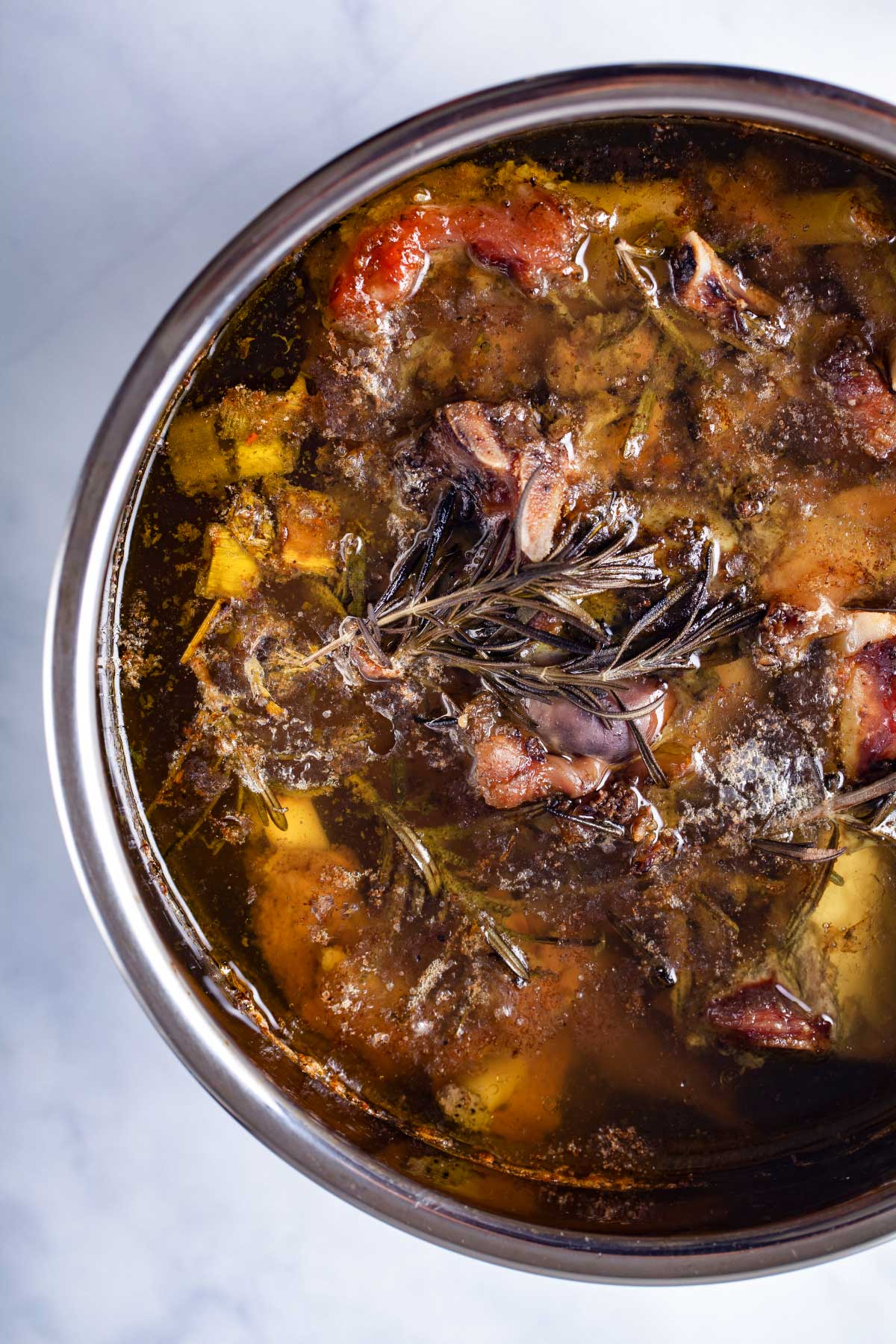
- Usually, I let the broth simmer in the slow cooker for 6 to 12 hours. At around the 8-hour mark, I am usually pretty satisfied with how the broth turns out.
- I would not go longer than 24 hours. After that, you will lose much more liquid and not get any more flavor benefits.
- But my motto is to check the broth and trust your senses.
- A meaty and soupy smell, a beautiful deep brownish color, fall-off-the-bone meat with softer bones, and a delicious taste test will tell you whether your bone broth is good enough.
Equipment You'll Need
A slow cooker or Crock Pot is ideal kitchen equipment. It's convenient, requires less attention than a Dutch oven or a stove pot, and slowly builds up all the flavors of bone broth.
Storage
In the fridge: Bone broth lasts for about 3 to 4 days.
- Remove meaty bones and allow the broth to cool at room temperature.
- Strain the liquid before storing each batch of bone broth in airtight containers.
- Always skim off any fat that has hardened at the top before reheating the broth or using it in other dishes. You can store that fat in mason jars with a lid in the fridge and use it instead of butter or oil to pan-fry or stir-fry other dishes.
Freezer Instructions: If you don't consume the bone broth within the next few days after making it, store it in the freezer.
- Once cooled, strain the liquid and store it in glass jars or glass food storage containers. Leave enough room at the top for the broth to expand.
- The broth keeps well in the freezer for about 6 months. Defrost by placing it in the fridge the night before.
- If you have only a little bit left, you can store any remaining broth in ice cube trays. You can quickly use them in your flavored cold-brew coffee or latte or make an iced bone broth cocoa.
Uses Of Bone Broth
Here are a few of my favorite ways to enjoy it.
- Use it to complement hearty soups like my Asian-inspired Bok Choy Soup, Purple Soup, or stews.
- Add heartiness to rice or quinoa dishes by cooking those grains in bone broth.
- Sip broth in a mug for breakfast with a touch of sea salt. It is incredibly satisfying.
- Use bone broth to make hot chocolate (it's delicious) in a small saucepan.
- Drink it like a cup of hot tea in the afternoon or before your evening meal. Reheat over the stove, add a little extra vegetable and broth seasoning and some fresh chopped Parsley leaves to stimulate the appetite and improve digestion.
- Use it as a base for gravy or sauces.
- For later use: Add flavor to this healthy mashed cauliflower and stir-fry vegetables.
- Or incorporate it into smoothies.
Note: When drinking bone broth for breakfast or a pick-me-up afternoon drink, I often sprinkle it with fresh chopped parsley and cilantro or season it more with black pepper or even a touch of grated Parmesan cheese—my favorite way. Find what you like best.
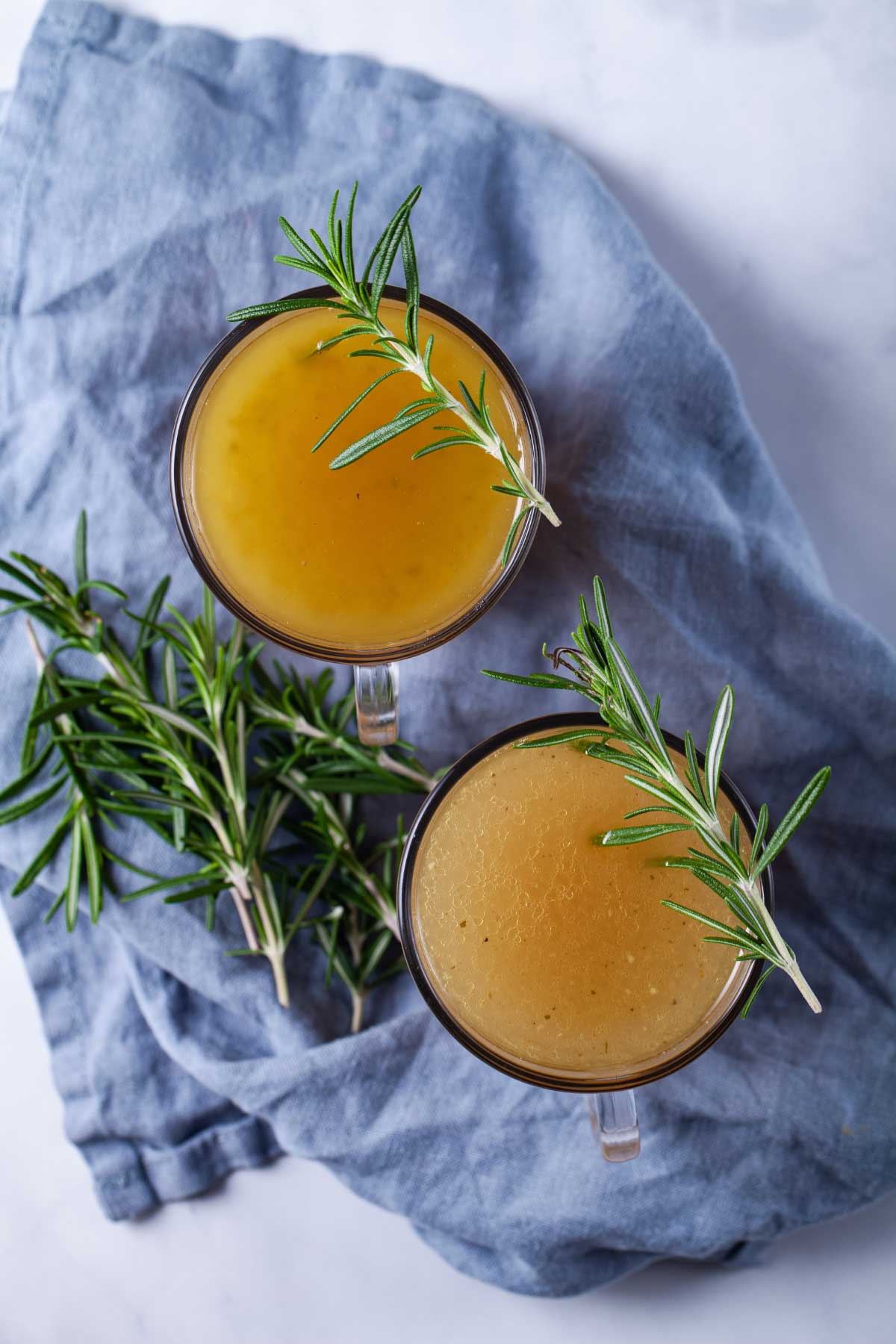
Broth Vs. Stock Vs. Bone Broth
Believe me; I use these words interchangeably at home. The difference between broth and stock is pretty straightforward, but we somehow added the term bone broth to the mix over the years, and the debates in the online culinary world were on fire, at least for a while. I'll explain the differences in the Recipe FAQs if you are interested. But know that I am referencing information passed on to me in the family kitchen.
Other Recipe FAQs
A good stock usually refers to an ingredient made with primarily (roasted) animal bones, associated connective tissues, and some vegetables, often onions, carrots, and celery. It is then simmered long enough on the stove to extract its rich collagen, minerals, and flavors.
Typically, it's minimally seasoned, and the strained liquid is often used as a base for other dishes. I usually don't use cooked stock immediately. More often, I let it cool completely and then refrigerate it overnight.
Then, I skim off a thick layer of fat congealed at the top, creating a lighter version of the stock—it's just how we did it at home. Once cooled in the refrigerator, good stock gels.
Depending on the bones and the simmer time, the liquid can become a little to very gelatinous after cooking. However, the gelatin melts again once reheated.
A broth is a deliciously flavored liquid made by simmering meat with or without bones, aromatic vegetables, and herbs in water over the stove until the meat is soft.
Like my fall-of-the-bone poached whole chicken recipe, I simmer a whole chicken with vegetables and herbs until the meat is super tender. I keep some of the meat in the broth for soups, and some you can use for pasta dishes or a chicken salad recipe.
Usually, the broth turns into a hearty (chicken) soup—like my Stracciatella soup. Even fish or vegetables with herbs can become a good broth base to extract their flavor.
For some, bone broth is simply a long-simmered stock. But for me, it's a bit of a mix between a stock and a broth.
Like a good stock, I simmer animal bones for several hours in water.
But I use raw meaty bones (or bones with some meat on them) and season them heavenly with aromatic veggies and herbs, so it becomes a delicious drink to consume on its own.
A good bone broth is richer in flavor, and the meaty bones are a delicious nibble.
I also usually simmer a bone broth much longer (at least 8 to 24 hours) or to the point where the bones almost fall apart.
It's a collagen-rich stock that is nutritious, incredibly savory, and can immediately be enjoyed as a drink.
I usually get mine at my local farmer's market, but I can often order them in advance online.
But if you ask for soup bones at the butcher stand in your local grocery store, they'll likely have them in the back and gladly sell them.
I encourage you to get organic bones, 100% grass-fed beef bones, or bones from a pastured chicken. The small extra cost is so worth it for your health and difference in taste.
Sometimes, you can find the healthiest and most reasonably priced sustainable food online.
While it is possible to use a pressure cooker or instant pot, I've noticed that the broth did not have the same richness and deep flavors as when you use a slow cooker or crock pot.
If you must use an instant pot, your best time is 2 hours on a high-pressure setting.
If you plan to be home the whole day or have a lazy Sunday, you can make this recipe on the stovetop and in a large enough pot ( 8 QT ). Count for a minimum of 8 to 12 hours of gentle simmer time.
I am not keen on leaving the stove on overnight. So, if I use the stovetop method, I prepare everything in the morning and watch it while doing other things at home.
Nothing beats homemade bone broth, but if you want something ready for those exceptionally hectic days, you can find it at the grocery store.
Look for "Bone broth" in the aisle with all the stocks, broth, and bouillons. Some stores carry fresh bone broth in the freezer.
It usually lasts a week in the fridge or one year in the freezer.
They have various choices and flavors, but it all comes down to what you like.
If you have a canine friend at home, the broth's incredible aromas will make your dog want to join in on all that goodness. Our dog, Porthos, certainly goes crazy for homemade bone broth.
I usually use a couple of tablespoons to flavor his lunch or dinner. If you plan to make this with your dog friend in mind, leave out the onions and any vegetables related to onions, like leeks and scallions.
I would go with chicken neck or beef bones and keep it simple with your choice of vegetables, like carrots or celery stalks. I always use a bit of garlic. It is not bad for dogs in minimal amounts, but leave it out when in doubt.
Recommended
Have questions? Simply comment below or message me. If you make this recipe, please leave a comment and a starred review below. Thank you!
Don't forget to subscribe to my Monthly Newsletter!
📖 Recipe

A Hearty Slow Cooker Bone Broth
Mariska RamondinoIngredients
- 3 cups vegetable ends from carrots, shallots, green onions, or dark green ends of leeks
- 1 large yellow onion peeled and coarsely chopped (you can also use celery instead)
- 3 cloves garlic crushed
- 3 to 5 pounds beef bones or beef marrow bones if preferred, you can also use pork neck bones or chicken necks
- 2 tablespoons apple cider vinegar
- 2 cubes vegetable bouillons optional
- Black pepper 10 turns with the pepper mill
- 2-3 sprigs fresh Thyme or Rosemary
- 2 tablespoons sea salt
- Water
Instructions
- In an 8 QT slow cooker, cover the bottom with all the vegetable ends, the onion, and the garlic.3 cups vegetable ends from carrots, shallots, green onions, or dark green ends of leeks, 1 large yellow onion, 3 cloves garlic
- Add the meaty bones and pour the vinegar over them—season with salt or vegetable broth seasoning and pepper. Then throw in the fresh sprigs.3 to 5 pounds beef bones or beef marrow bones, 2 tablespoons apple cider vinegar, Black pepper, 2-3 sprigs fresh Thyme or Rosemary, 2 tablespoons sea salt
- Cover everything with water but leave about 1-inch space between any liquid and the pot's rim or fill the pot to its maximum capacity.
- Throw in the vegetable bouillons (optional)2 cubes vegetable bouillons
- Cook on low for 8 to a maximum of 24 hours.
- When ready, allow the broth to cool. Remove the big pieces of meat with a large slotted spoon, then strain the stock into a large bowl.
- Transfer the liquid to airtight containers and refrigerate up to 4 days or freeze up to 6 months.
- Immediately enjoy the meat bones or peel off the soft meat and enjoy in casseroles, omelets, etc.
Notes
Add your own private notes
Whenever you come back to this recipe, you’ll be able to see your notes.
Nutrition (% Daily value)
Disclaimer: This nutritional data is calculated using third party tools and is only intended as a reference.


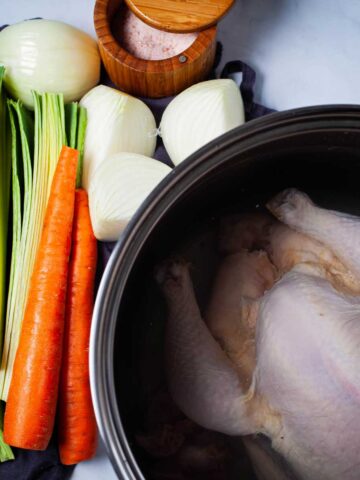
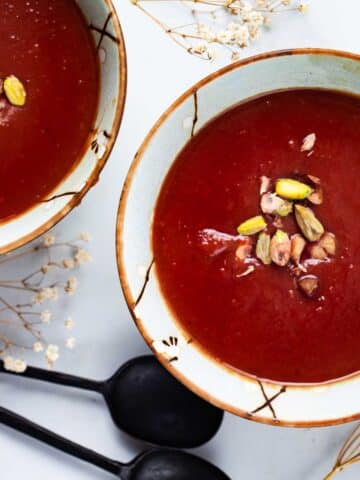


Leave a Reply